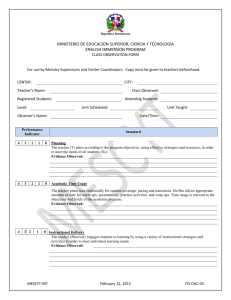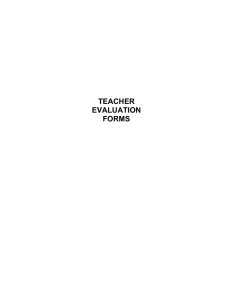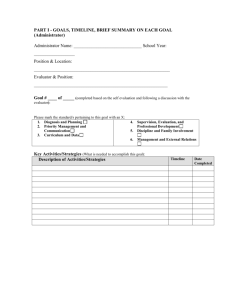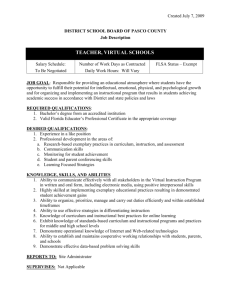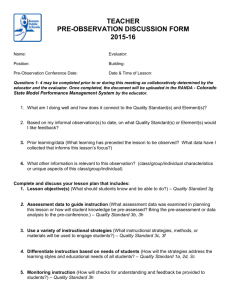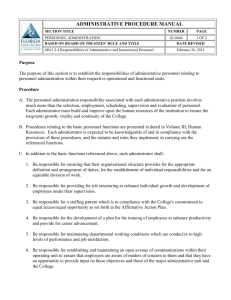conference presentation
advertisement
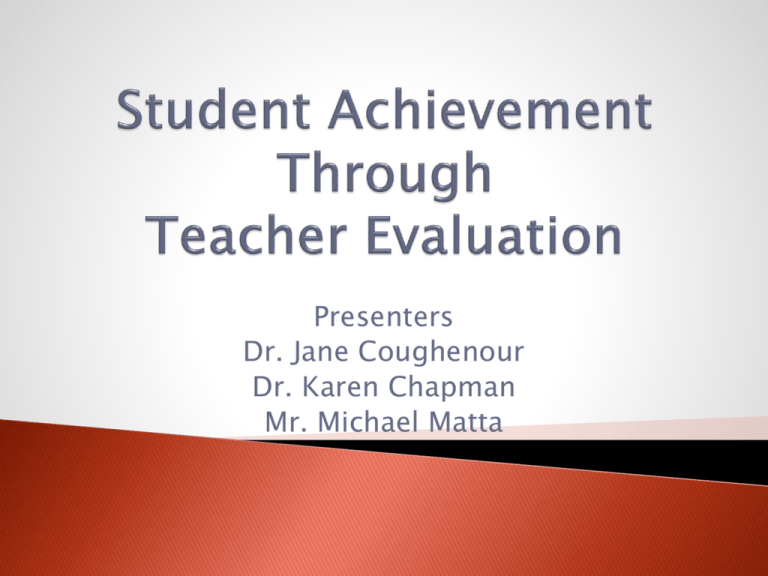
Presenters Dr. Jane Coughenour Dr. Karen Chapman Mr. Michael Matta Staff at McKeesport Area School district worked to create an evaluation process that culminates with a teacher showing evidence of student growth. District motto “Move, Engage, Assess” drives components of the evaluation process. Members of the evaluation committee included: ◦ Assistant Superintendent ◦ Director of Federal Programs ◦ District Technology Integrator ◦ 2 Board Members ◦ Principal ◦ 9 teachers Assign a Central Office Administrator to each building Create a district wide informal observation form aligned to the Teacher Effectiveness Model Create a district wide walkthrough and instructional round form Creation of a teachers’ personal academic goal Use of an online software package to collect and analyze data from teacher walkthroughs Student engagement and discourse drives instruction through: ◦ ◦ ◦ ◦ ◦ Cooperative learning Formative assessment Critical thinking activities Performance activities High level questioning Teacher is a facilitator in the classroom, not a lecturer. Students drive instruction, not subject content. Formative assessment is an essential component of instruction achieved through: ◦ ◦ ◦ ◦ ◦ Individual whiteboards Ticket out the door Journaling Technology Questioning These targeted strategies are reflected the District’s Motto: “Move, Engage, Assess”. Using Activators (bell ringers, etc.) Setting the Purpose for Instruction Modeling the Task Chunking the Lesson Scaffolding Tasks Differentiating to Student Needs Adding Rigor to Each Lesson Use of Collaborative Groupings Real-Life Connections Increasing Student Discourse Techniques (i.e. Turn and Talks, Re-teaching, Group Tasks, Group members’ Report-Outs, etc.), Formative and Random Assessment Techniques (i.e. All-Student Response Systems, Individual White Boards, Thumbs-Up/Down, Random Reporter, Popsicle-Stick Drawing, etc. Walk-through Instructional Round Formal Observation Informal Observation Teachers’ Personal Academic Goal Walk-through is conducted 2 or 3 times each 9 weeks for each teacher. Observation is only 5 minutes in length. Observer looking for components of district motto “Move, Engage, Assess”. Walk-through is not evaluative. Walk-through encompasses 4 domains ◦ ◦ ◦ ◦ Student engagement Teacher interaction Evidence of district-wide expectations Positive climate and teacher efficacy District motto drives what is observed during an Instructional Round. Instructional rounds may consist of a principal, curriculum director, teacher(s), and/or central administrator. Instructional rounds last 20 minutes. There is a group discussion to discuss group members’ observations. Teachers are encouraged to infuse specific targeted instructional strategies into their lesson design to increase: ◦ ◦ ◦ ◦ Active teacher engagement Active student engagement Instructional rigor Assessment for learning To begin the process of including peers, we turned to teacher leaders who had success and a comfort level with Instructional Rounds (IRs). ◦ Teachers district wide agreed to allow their peers in to view, and reflect on, their showcase lessons. ◦ Teachers were asked to conduct a model showcase lesson. ◦ Teachers permitted video-taping of their lesson to be placed on Teacher Compass for view by other staff members. ◦ Videos served as a means for professional development A Peer Invitation System was developed… ◦ We used an e-mail distribution list specific to teachers’ period plans. If the PIR lesson was period 4 at the high school, all teachers with plans in period 4 were invited. Building and district administrators were also invited. Forms were prepared in advance: ◦ ◦ ◦ ◦ PIR PIR PIR PIR Post-Observation Meeting Agenda Signature Sheet (Act 48 purposes) Ground Rules for Reflection Form to Track Participation For planning and performing a Peer Instructional Round (PIR)… ◦ The teacher was awarded a Certificate of Recognition signed by superintendent. ◦ The teacher was recognized on the district webpage. ◦ For giving up a plan period to observe and reflect on a peer’s lesson, the teacher was awarded ½ hour Act 48 Credit under professional development. E-Mails of Invitations ◦ Invitations were sent 2 days prior to each PIR. ◦ E-mails included the date, period, time, room number and reminded invitees about the Act 48 incentive for viewing and reflecting on a PIR . ◦ The e-mail also gave the purpose of the PIR (to build a Professional Learning Community around engaging and rigorous instructional strategies). A last minute reminder e-mail was sent the morning of each PIR. These encouraged last minute drop-ins. Each visiting teacher was given a copy of the Peer Instructional Round Form as they entered the showcase lesson. They were told they didn’t need to use it, but could use it for reference. They were told that the form would drive the post-conference reflection. All visitors were reminded of the ground rules. ◦ Positive Comments Only ◦ Identify where and when in the lesson targeted strategies were observed ◦ Share strategies that were successes in their own classroom During the post PIR reflection, the targeted instructional strategies are read from the PIR form and teachers identify if and when the strategies were viewed in the lesson. ◦ Teachers are encouraged to share strategies that have been effective for them in their lesson design and implementation. This facilitates professional growth, not only through the viewing of the lesson, but also through these discussion and reflection. Teachers with 1 to 3 years of teaching experience Teacher will have 2 observations using the 426 observation rubric and evaluation system Each observation will last a minimum of 35 minutes A post conference is held after each observation Employee must attain an additional 24 credits at a University or AIU Following attainment of 24 credits and 6 satisfactory ratings, professional employee may apply for level II certification through TIMS (www.state.pa.us) Level II employees in years 3 – 6 receive a formal observation Professional employees MUST receive a formal observation every three years Career level employees are observed using PDE’s Teacher Effectiveness Model for their formal observation. Through a differentiated model, teachers may select an informal observation between years of their required formal observations Principal/Supervisor conducts classroom observations, including evidence that demonstrates behaviors associated with improving student achievement Who collects/provides evidence? Both teacher and evaluator Evaluation is not done TO you; it is done with you and for you Common language Similar vision for good teaching and how it can be improved Greater validity and reliability in the teacher evaluation process Changes in novice thinking Opportunities for collaboration Generic: applies to all grade levels, content areas Not a checklist ◦ Evidence based/reflective Not prescriptive: tells the “what” of teaching, not “how” Comprehensive: not just what we can see Inclusive: Novice to Master teacher Pennsylvania has adopted Charlotte Danielson's Framework for Teaching as the overarching vision for effective instruction in the Commonwealth. The model focuses the complex activity of teaching by defining four domains of teaching responsibility: Domains (Danielson’s Framework for Teaching) ◦ ◦ ◦ ◦ Planning and Preparation Classroom Environment Instruction Professional Responsibilities 4 Domains 22 components 4 possible ratings for each component Unsatisfactory – Potential for harm Progressing / Needs Improvement - Inconsistent, novice Proficient - Competent Distinguished - Unusually excellent, no one “lives” here permanently in all components Demonstrating knowledge of content and pedagogy Demonstrating knowledge of students Setting instructional objectives Demonstrating knowledge of resources Designing coherent instruction Designing student assessments Teacher wrote a scholarly article Lesson plans/structure/content/relevance Teacher explanation of probable students’ misconceptions Teacher presented a workshop to faculty Teacher explains the structure of discipline prior to lesson Teacher tells observer how this lesson fits into the larger unit Teacher states how this lesson connects to content standards Creating an environment of respect and rapport Establishing a culture of learning Managing classroom procedures Managing student behavior Organizing physical space Figure 6.7 DOMAIN 2: THE CLASSROOM ENVIRONMENT COMPONENT 2A: CREATING AN ENVIRONMENT OF RESPECT AND RAPPORT Elements: Teacher interaction with students Student interaction L E V E L O F P E R F O R M A N C E NEEDS IMPROVEMENT OR PROGRESSING PROFICIENT DISTINGUISHED Teacher interaction with at least some students is negative, demeaning, sarcastic, or inappropriate to the age or culture of the students. Students exhibit disrespect for teacher. Teacher-student interactions are generally appropriate but may reflect occasional inconsistencies, favoritism, or disregard for students’ cultures. Students exhibit only minimal respect for teacher. Teacher-student interactions are friendly and demonstrate general warmth, caring, and respect. Such interactions are appropriate to developmental and cultural norms. Students exhibit respect for teacher. Teacher demonstrates genuine caring and respect for individual students. Students exhibit respect for teacher as an individual, beyond that for the role. Student interactions are characterized by conflict, sarcasm, or put-downs. Students do not demonstrate negative behavior toward on another. Student interactions are generally polite and respectful. Students demonstrate genuine caring for one another as individuals and as students. ELEMENT UNSATISFACTORY Teacher Interaction with Students Student Interaction Communicating with students Using questioning and discussion techniques Engaging students in learning Using assessment in instruction Demonstrating flexibility and responsiveness Teacher’s answers student questions during class Teacher adjusts the lesson midstream based on students’ misconceptions Teacher poses different levels of content questions during the lesson Use of formative assessment during instruction Student led / cooperative instruction Higher order questioning utilized by teacher (not all recall in nature) Reflecting on teaching Maintaining accurate records Communicating with families Participating in a professional community Growing and developing professionally Showing professionalism Pre-Observation – Domain 1 and 4 2 days before: Teacher provides evidence using Lesson Plan Form Teacher and Evaluator discuss evidence provided; Evaluator Collects additional Evidence through Questioning Where did your group mark the During the Observation – Domains 1, 2 and 3 or above proficient? Evaluator arrives early – Walks the Walls lesson at Evidence Collected during the lesson: Avoid Opinions Where did your group mark below proficient? Preparing for Post-Observation – Domains 1, 2, 3 and 4 Evaluator provides Teacher with Evidence Collected during the Observation Teacher self-assesses using highlighter and rubric –and gives to evaluator Evaluator assesses and marks all agreed upon – leaves areas of concern blank to discuss Post-Teaching Collaborative Assessment – Domains: 1, 2, 3 and 4 Teacher and Evaluator discuss agreed upon items Evaluator invites teacher to discuss areas of disagreement Teacher develops self-assessment summary 37 Teacher selects the day and time of the conference Teacher receives the worksheet encompassing domain 1 and 2 prior to the pre-conference During the pre-conference, teacher will speak about the lesson to be observed, noting standards, instructional strategies to be used, etc. Administrator will work through domain 1 at this time (planning and preparation), taking notes during the meeting. Some elements of domain 4 (professionalism) may be answered at this time. Observation is to last a minimum of 35 minutes Administrator will take notes on what is “OBSERVED” in domains 2 (classroom environment) and domain 3 (instruction) Administrator’s notes are to relate what is observed and cannot be subjective All elements in domain 2 and 3 will receive a rating of unsatisfactory, needs improvement, proficient, or distinguished Verbatim scripting of teacher or student comments: “Could one person from each table collect materials?” Descriptions of observed teacher or student behavior: The teacher stands by the door, greeting students as they enter. Numeric information about time, student participation, resource use, etc.: Three students of the eighteen offer nearly all of the comments during discussion. An observed aspect of the environment: The assignment is on the board for students to do while roll is taken. 40 Teacher will receive the teacher effectiveness rubric to “self-assess” their lesson observed. Teacher will have no more than one week to complete the rubric and return it to the administrator that observed him / her. Administrator will schedule a post-conference upon completion of the teacher self-assessment To discuss the components of difference (not yet marked by observer) To elicit any evidence that still remains to be added about the lesson To arrive at an assessment on the rubric for components of difference. To select and agree upon two areas of instruction that will be highlighted and looked for during the walkthrough Observation will be placed in Teacher Compass Teacher and administrator will sign the signature form for meeting attendance 42 A walk-through utilizing the appropriate PDE form will be conducted by the administrator The walk-through is unannounced Only the two areas identified during the postconference will be noted during the walk-through The walk-through will last 15 minutes The administrator will take notes and the walkthrough will be placed in Teacher Compass Informal observation is unannounced Observation is 15 minutes in length Informal observations may be conducted on Level II professional employees after 6 years of service Danielson’s rubric are utilized in the informal observation A summary is written of components seen during the observation Observer looking for components of the district motto. Planning and Preparation ◦ 8 elements Classroom Environment ◦ 10 elements Instruction ◦ 14 elements Professionalism ◦ 7 elements Teachers are evaluated in all 39 elements Teachers receive a: ◦ Yes - was observed ◦ No - was not observed ◦ NA - not applicable Not applicable was included for those education professionals who may not teach in a classroom Observation notes are included after each domain Notes are to show what saw “seen” and not perceptions or opinions of the administrator What is a personal academic goal? What am I to assess? What happens if my students don’t show growth? How much growth do students need to show? Will I receive an unsatisfactory rating? Goal must address a standard within the teachers’ grade level and/or academic area. Goal is to be attainable and not all encompassing. Goal is to be submitted to building administrator for approval. Every student who takes / has that particular class with the teacher are to be assessed ◦ Example: All students who take gym ◦ Example: All 8th grade students that take World Language (rotated through 4 nine week grading periods) Teacher is to collect data by testing students on the academic goal chosen. ◦ Elementary teachers test class ◦ Secondary teachers test every student of that course / class First test given at the start of the school year. Same data collection tool used after May 15. ◦ Teacher to submit data to building principal as evidence of student growth / regression 1. Hello A. Hola B. Guten Morgen C. Bonjour D. Guten Tag 2. How are you? A. Wie geht’s? B. Ça va? C. ¿Qué tal? D. Comme çi comme ça? 3. Please A. Merci B. Por favor C. Danke D. Bitte 4. My name is… A. Me llamo… B. Es fruet mich… C. Ich heisse… D. Je m’appelle… 5. See you later… A. A tout a l’heure B. Bis später C. Auf wiedersehen Bitten schön PERIOD 6 KB MB AC SF BH CJ MK JP HS JS RT MW PERIOD 8 AK SB HD LE JE PH KJ KL JM MR TT CR 5 5 5 2 3 4 1 1 5 2 1 5 4 8 8 6 3 5 6 7 6 5 4 8 2 6 3 3 6 2 2 2 6 0 2 2 4 5 5 6 7 6 2 7 5 3 3 7 0 -1 3 3 4 0 1 5 6 1 3 3 3 0 2 -1 2 3 1 4 0 5 -1 3 1 5 Final Score 5.805970149 Growth 2.083333333 Baseline Score AVERAGES 3.514705882 50% - Teacher Observation 15% - PSSA / Keystone Data 15% - Teacher Specific Data ◦ Personal Academic Goal ◦ Students receive pre- post test on a standard selected by the teacher 20% - Elective Data ◦ Attendance data ◦ Common Assessments ◦ Plato Testing, Dibbles, etc. http://teachercompass.pearsoncmg.com Teacher Compass is an on-line program that houses all district observations / evaluations. Reports can be generated for individual teachers and the building. Videos for professional development are available to attach to teacher observations. Components of Teacher Compass: ◦ ◦ ◦ ◦ ◦ ◦ Teacher listing Rubrics Videos for professional development Individual teacher reports Building report for Walk-throughs Data analysis for building / teacher strengths and concerns
